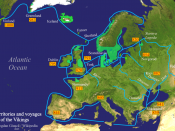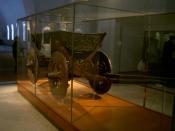Through most of the Viking Age, the Scandinavians were Pagans, and like other religions, much of their daily activity revolved around their beliefs. They believed in many different gods and goddesses and had high admiration for them. Each one of their gods represented a different function that went hand and hand with their everyday living. In order to keep a good relationship, the Vikings believed that they had to satisfy their gods, which they did by such things as sacrifices. The Vikings also had a vague idea of the afterlife that was reflected in the way they lived, died, and buried their dead. They continued to practice their Pagan religion until around the year 1000, when the Viking colonies accepted Christianity1.
The Viking religion, often referred to as the Norse religion, was full of myths and legends and those often revolved around their gods. In order to fully understand the Pagan religion of the Vikings, one must understand the gods that they so faithfully worshiped.
They believed that their gods were more powerful than men, but unlike the Christian God, the Viking gods were not all-powerful or all knowing. The gods had humanly characteristics, and like men they fought, played jokes, could be deceived and would eventually die. The gods themselves were bound by their fates, and doomed to die at the end of the world. After which, they and the world, were to be reborn and the cycle continued2.
According to Viking mythology, there are two families of gods, the Aesir and the Vanir. The Aesir was the larger of the two. The Aesir came from Germany while the Vanir were Scandinavian. The Viking religion was actually not just one religion, but many. The emphasis on certain gods varied according to which country one was in and also...


